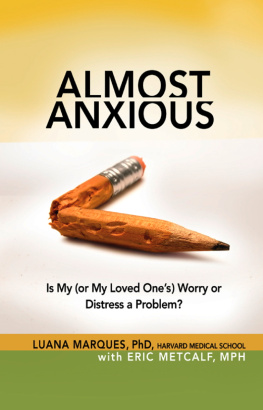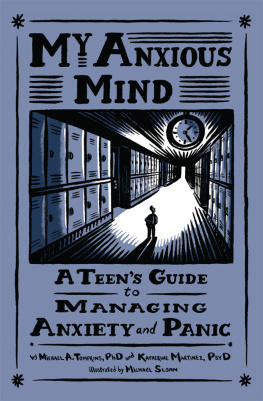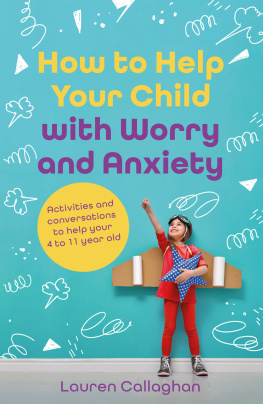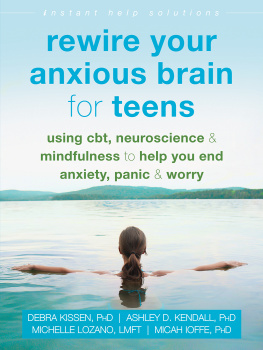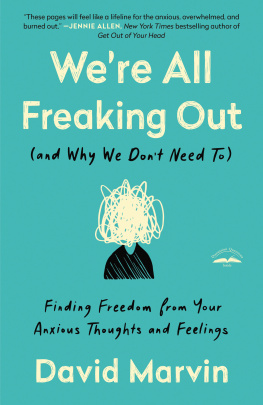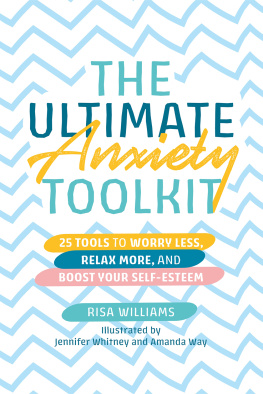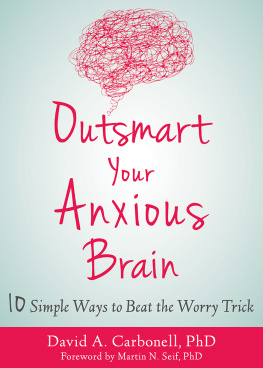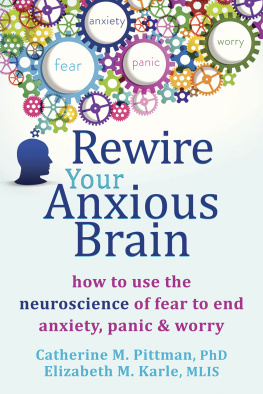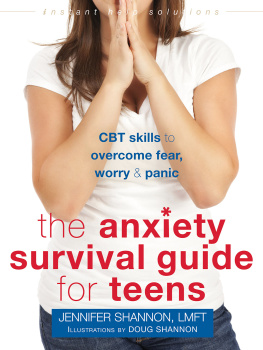ALMOST
ANXIOUS
ALMOST
ANXIOUS
Is My (or My Loved Ones)
Worry or Distress a Problem?

Luana Marques, PhD, Harvard Medical School
with Eric Metcalf, MPH
Hazelden Publishing
Center City, Minnesota 55012
800-328-9000
hazelden.org/bookstore
2013 by Harvard University
All rights reserved. Published 2013.
Printed in the United States of America
No part of this publication, either print or electronic, may be reproduced in any form or by any means without the express written permission of the publisher. Failure to comply with these terms may expose you to legal action and damages for copyright infringement.
Library of Congress Cataloging-in-Publication Data
Marques, Luana.
Almost anxious: is my (or my loved ones) worry or distress a problem? / Luana Marques, PhD, Harvard Medical School, with Eric Metcalf, MPH.
pages cm
Includes bibliographical references.
ISBN 978-1-61649-447-6 (pbk) ISBN 978-1-61649-469-8 (ebook)
1. Anxiety. 2. Anxiety disorders. 3. Worry.
I. Metcalf, Eric. II. Title.
RC531.M35 2013
616.8522dc23
2013021530
Editors notes:
The case examples in this book are composite examples based upon behaviors encountered in the authors own professional experience. None of the individuals described in this book are based on a specific patient, and all identifying details in the composite examples have been changed to protect the privacy of the people involved.
This publication is not intended as a substitute for the advice of health care professionals.
17 16 15 14 13 1 2 3 4 5 6
Cover design by Theresa Jaeger Gedig
Interior design and typesetting by Kinne Design
The Almost Effect series presents books written by Harvard Medical School faculty and other experts who offer guidance on common behavioral and physical problems falling in the spectrum between normal health and a full-blown medical condition. These are the first publications to help general readers recognize and address these problems.

For Dona Maria Helena Esteves Martins
my first psychology mentor
List of Figures
List of Exercises
series foreword
The Almost Effect
I once overheard a mother counseling her grown daughter to avoid dating a man she thought had a drinking problem. The daughter said, Mom, hes not an alcoholic! The mother quickly responded, Well, maybe not, but he almost is.
Perhaps youve heard someone, referring to a boss or public figure, say, I dont like that guy. Hes almost a psychopath!
Over the years, Ive heard many variations on this theme. The medical literature currently recognizes many problems or syndromes that dont quite meet the standard definition of a medical condition. Although the medical literature has many examples of these syndromes, they are often not well known (except by doctors specializing in that particular area of medicine) or well described (except in highly technical medical research articles). They are what medical professionals often refer to as subclinical and, using the common parlance from the examples above, what were calling the almost effect.
For example:
- Glucose intolerance may or may not always lead to the medical condition of diabetes, but it nonetheless increases your risk of getting diabeteswhich then increases your risk of heart attacks, strokes, and many other illnesses.
- Sunburns, especially severe ones, may not always lead to skin cancer, but they always increase your risk of skin cancer, cause immediate pain, and may cause permanent cosmetic issues.
- Pre-hypertension may not always lead to hypertension (high blood pressure), but it increases your risk of getting hypertension, which then increases your risk of heart attacks, strokes, and other illnesses.
- Osteopenia signifies a minor loss of bone that may not always lead to the more significant bone loss called osteoporosis, but it still increases your risk of getting osteoporosis, which then increases your risk of having a pathologic fracture.
Diseases can develop slowly, producing milder symptoms for years before they become full-blown. If you recognize them early, before they become fully developed, and take relatively simple actions, you have a good chance of preventing them from turning into the full-blown disorder. In many instances there are steps you can try at home on your own; this is especially true with the mental and behavioral health disorders.
So, what exactly is the almost effect and why this book? Almost Anxious is one of a series of books by faculty members from Harvard Medical School and other experts. These books are the first to describe in everyday language how to recognize and what to do about some of the most common behavioral and emotional problems that fall within the continuum between normal and full-blown pathology. Since this concept is new and still evolving, were proposing a new term, the almost effect , to describe problems characterized by the following criteria.
The problem
- falls outside of normal behavior but falls short of meeting the criteria for a particular diagnosis (such as alcoholism, major depression, psychopathy, anorexia nervosa, or substance dependence);
- is currently causing identifiable issues for individuals and/or others in their lives;
- may progress to the full-blown condition, meeting accepted diagnostic criteria, but even if it doesnt, still can cause significant suffering;
- should respond to appropriate interventions when accurately identified.
The Almost Effect

All of the books in The Almost Effect series make a simple point: Each of these conditions occurs along a spectrum, with normal health and behavior at one end, and the full-blown disorder at the other. Between these two extremes is where the almost effect lies. It is the point at which a person is experiencing real pain and suffering from a condition for which there are solutions if the problem is recognized.
Recognizing the almost effect not only helps a person address real issues now; it also opens the door for change well in advance of the point at which the problem becomes severe. In short, recognizing the almost effect has two primary goals: (1) to alleviate pain and suffering now, and (2) to prevent more serious problems later.
I am convinced these problems are causing tremendous suffering, and it is my hope that the science-based information in these books can help alleviate this suffering. Readers can find help in the practical self-assessments and advice offered here, and the current research and clinical expertise presented in the series can open opportunities for health care professionals to intervene more effectively.
I hope you find this book helpful. For information about other books in this series, visit www.TheAlmostEffect.com.
Julie Silver, MD
Associate Professor, Harvard Medical School

